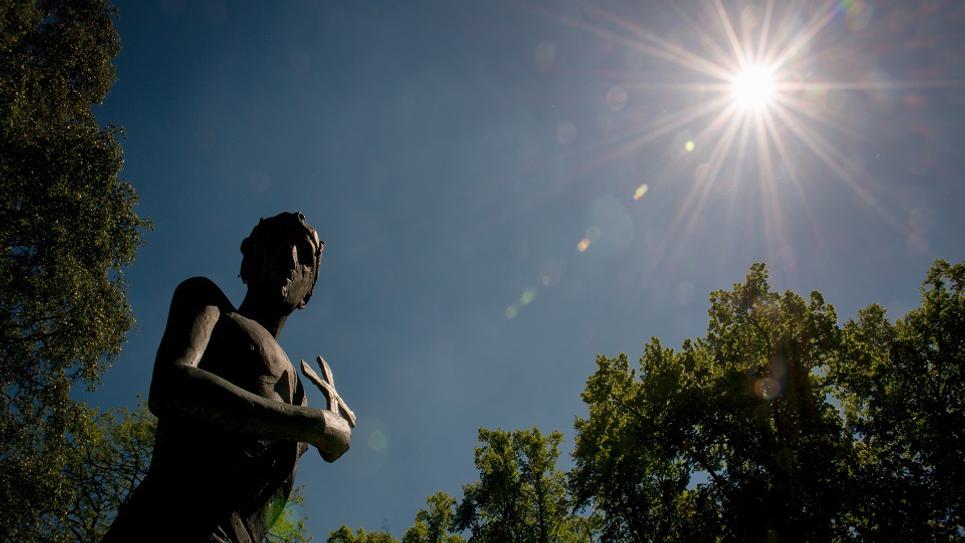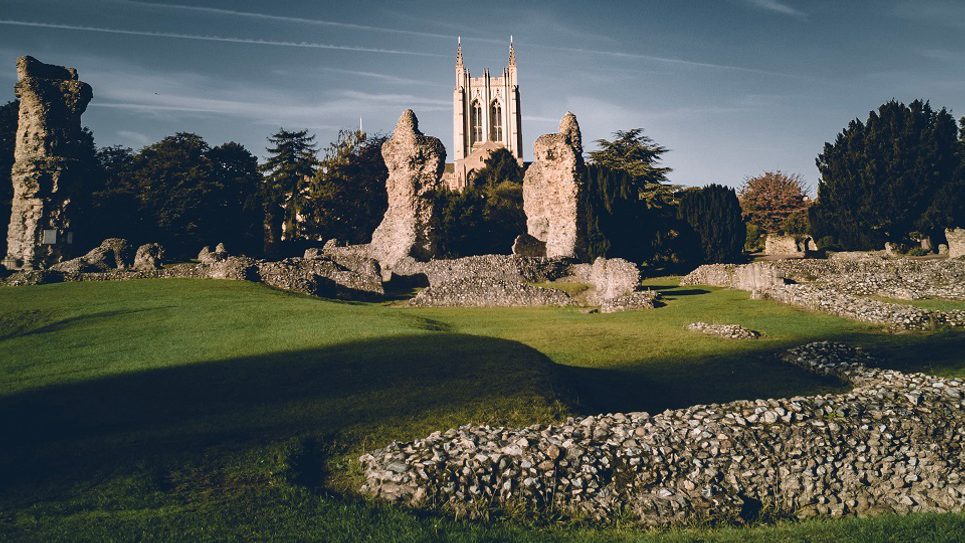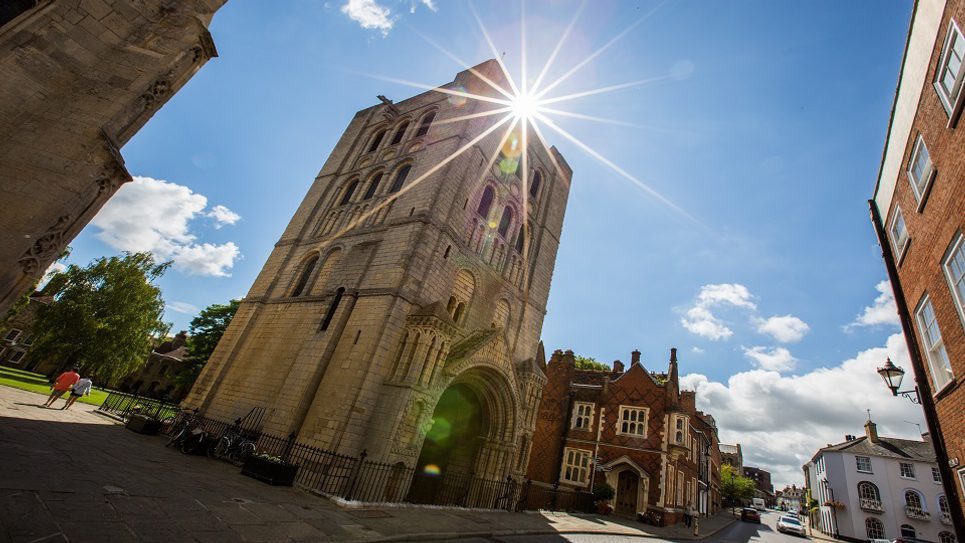
Back to Blogs
Discover
Bury St Edmunds' Most Instagrammable Spots!
With over 1000 years of history, it's no surprise that Bury St Edmunds features prominently on the Instagram grid!
Here are our Top instagram spots in Bury St Edmunds. So go on, get out there with your camera or smart phone! Don't forget to tag us on Instagram @burystedmundsandbeyond.
The statue of St Edmund

Lovingly sculptured by Dame Elisabeth Frink, the statue of a young Edmund (the original Patron Saint of England) along with a wolf on guard, is located in the Great Churchyard beside St Edmundsbury Cathedral.
Bury St Edmunds takes its name from King Edmund, the original Patron Saint of England and King of the East Angles, who is widely believed to be buried in the town. The legend of St Edmund, who ruled East Anglia from AD 855 to 869, tells of the brave King Edmund who was killed by the Vikings after refusing to denounce his Christianity.
Why the wolf? The story goes that after being killed with arrows and decapitated in Suffolk, the king's body was found but his head was missing. Supporters heard the wolf call them and they found him guarding the king's head, which was then reunited with his body.
The statue is the perfect fusion of old and new, with the Churchyard and centuries old house surrounding the perfect backdrop for your snap.
The Abbey of St Edmund

Founded in 1020, the Abbey of St Edmund is almost a thousand years old, so it's a must for your insta-grid.
Once one of the greatest abbeys in the country and one of the richest, largest and most powerful Benedictine monasteries in England.
Its remains are extensive and include the complete 14th century Great Gate and Norman Tower, as well as the impressive ruins and altered west front of the immense church.
St Edmundsbury Cathedral

Experience a fascinating behind-the-scenes tower tour and remember to take your phone or camera to capture some truly insta-worthy scenes at St Edmundsbury Cathedral.
During the tour you will see rare views of the Cathedral itself and across the town and wider countryside and on some days as far as Ely from the tower - the highest point in Bury St Edmunds! The 160ft tower represents modern technology and traditional craftsmanship co-existing side by side.
Be sure to look out over the South Transept roof, and peek out of the Gallery onto the Quire to see the painted Nave roof up close. The tour also takes in the area above the vaulted ceiling before visiting the roof with its amazing views.
The Abbey Gate

Visitors can enter the Abbey Gardens through the impressive Abbey Gate complete with its portcullis.
The original gateway, entrance to the great courtyard of the Abbey of St Edmund, was destroyed in 1327 during the riots by the local people, who were angry at the power of the monastery. The Abbey Gate you can see today with its west side arrow slits was built in the 14th Century.
The Pillar of Salt, Angel Hill

Constructed in 1935 by Basil Oliver, architect to Bury St Edmunds town council in 1935, the Pillar of Salt road sign on Bury St Edmunds' historic Angel Hill is a Grade II listed road sign on Angel Hill.
When it was listed in 1998, it was described as being "individual and probably unique". According to the plaque set at the foot of the sign, it is thought to be the first internally illuminated road sign in the country.When it was constructed it had to be granted special permission because the height of the letters and numbers did not conform to regulations
It is no longer is used as a road sign for vehicles as the area has been pedestrianised, so you're able to get right next to it for your salt pillar selfie!
The Norman Tower

The Norman Tower, which was the principal gateway into Bury St Edmunds' great abbey church, was built between 1120 and 1148 and is one of the oldest Norman buildings in England and one of the most complete Norman buildings in the UK as it has never been altered.
Nowton Park

Nowton Park is renowned for the vivid display of daffodils that burst into life each spring but it is picture perfect in every season!
The park consists of over 200 acres of West Suffolk countryside. Take a leisurely woodland walk and admire the wildflower meadow, sown in 1990. The blossoming wildflowers attract a thriving butterfly population, introducing record numbers into the park. Alongside the picture perfect landscapes,
Nowton also has two scenic ponds, both of which are rich in aquatic life. Experience the original grandeur of the estate with a walk down the 19th century lime avenue, planted back in 1880.
The West Front

The West Front is a unique collection of houses, from various periods, built into the ruins of the vast west front of the Benedictine abbey; Abbey of St Edmund.
Standing in front of these homes, you can appreciate just how big the Abbey would have been. Look carefully and you can see remains of the three main arches flanked by a smaller arched opening on either side and with an octagonal tower at the south west end.
When taking photos of the West Front, please do be respectful that they are now private residences.
Feeling inspired? Why not stay longer and book a stay in Bury St Edmunds & Beyond! Take a look at our Places to Stay Guide
Related Posts
Related Blogs

News
Tours Take Off for Masters of…
Tours developed by Bury St Edmunds Tour Guides and…

News
Vote for Bury St Edmunds Tour…
Vote now to Help Bury St Edmunds Tour Guides win the…

News
See Rendlesham Revealed at…
1,400-year-old Anglo-Saxon artefacts from National…

News
New afternoon tea at Lavenham…
Enjoy a Masters of the Air themed afternoon tea at The…

News
Itinerary: Masters of the Air
Follow in the footsteps of the Master of the Air
Latest news

News
Discover Suffolk's County Flower - the Oxlip
Did you know that Suffolk has a county flower? The Oxlip only grows in some woodland areas of Suffolk, Cambridgeshire and Essex.

News
Quentin Blake ‘The Illustrated Hospital’ exhibition at Bury St Edmunds Museum
A summer exhibition of illustrations by Quentin Blake at Moyse’s Hall Museum, Bury St Edmunds presents a rare opportunity to view a large collection of pieces by one of the nation’s favourite artists.

News
Abbey Project Awarded National Lottery Heritage Fund Grant
The project aims to conserve and protect the ruins; build a visitor centre, west cloister, and network of footpaths; and use digital technology to provide exciting interpretation for all ages and…

News
Walks at Rougham
Rougham Estate offers 18 miles of public footpaths, cycling routes and permissive pathways for you to enjoy.

News
Bury St Edmunds Celebrates English Tourism Week
Bury St Edmunds MP, Jo Churchill, met representatives from the town’s attractions and tour guides involved with the town’s Masters of the Air tourism campaign at Bury St Edmunds Guildhall.

News
Tours Take Off for Masters of The Air
Tours developed by Bury St Edmunds Tour Guides and Bury St Edmunds Guildhall to tie in with the Apple TV Series Masters of The Air so popular more dates are being added.

News
International illustrator David Hughes draws largest exhibition Bury St Edmunds
The largest ever exhibition is now underway at Moyse’s Hall Museum featuring the work of internationally acclaimed illustrator David Hughes.

News
A Taste of Bury St Edmunds and Suffolk
After visiting Suffolk's foodie capital, you'll want to take it with you - here are 5 foodie treats to take home!

News
Doctor Who Stars Coming to Bury St Edmunds to Star in Sherlock Holmes Classic
Who stars Colin Baker, Terry Molloy, and Rosie Baker will star in Hound of The Baskervilles at Bury St Edmunds Theatre Royal



